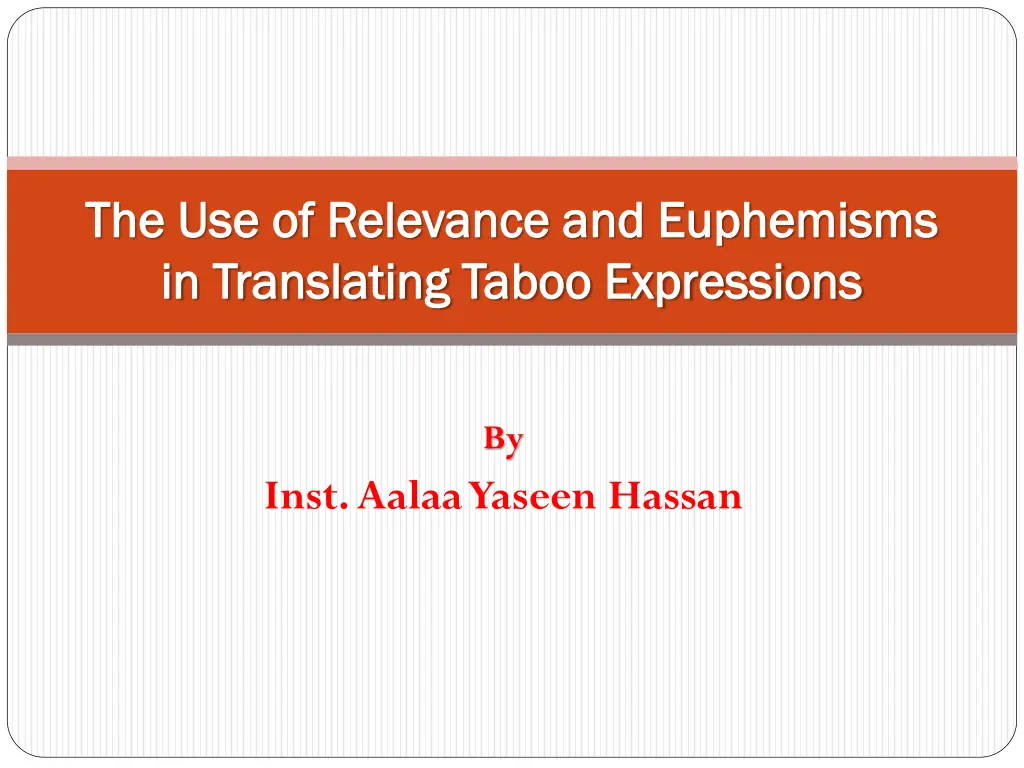
Euphemisms in Translating Taboo Expressions: A Cultural Perspective
Explore the use of relevance and euphemisms in translating taboo expressions, focusing on the challenges faced by subtitle translators in conveying precise meanings within cultural contexts. Learn about Relevance Theory and its impact on translation practices.
Download Presentation

Please find below an Image/Link to download the presentation.
The content on the website is provided AS IS for your information and personal use only. It may not be sold, licensed, or shared on other websites without obtaining consent from the author. If you encounter any issues during the download, it is possible that the publisher has removed the file from their server.
You are allowed to download the files provided on this website for personal or commercial use, subject to the condition that they are used lawfully. All files are the property of their respective owners.
The content on the website is provided AS IS for your information and personal use only. It may not be sold, licensed, or shared on other websites without obtaining consent from the author.
E N D
Presentation Transcript
The Use of Relevance and Euphemisms The Use of Relevance and Euphemisms in Translating Taboo Expressions in Translating Taboo Expressions By Inst. AalaaYaseen Hassan
Main Points Main Points The use of relevance and euphemisms in translating taboo expressions. Translation presents various challenges to translators, particularly in the translation of relevance and taboo expressions. Especially, subtitle translations. Subtitle translators should pay close attention to the cultural and social norms of the target audience and convey precise translations of taboo expressions to ensure the optimal meaning is conveyed accurately
Relevance Theory Relevance Theory Relevance Theory (RT) was introduced by Sperber and Wilson (1986) in their book Relevance:Communication and Cognition . This approach is based on the assumption that human cognition is geared towards the hearer's search for relevance (the maximization of relevance) (Abdulmajeed &Abed,2021).
Cognitive Principle & Communicative Cognitive Principle & Communicative Principle. Principle. There are two principles in this theory:the cognitive principle and the communicative principle. The first is related to cognition, and the second to communication or the interpretation of utterance (Sperber andWilson,1995). It is explained in two ways: cognitive effects (reward): the listener tries to connect the new information with the old oneS to get the contextual implications (Sperber &Wilson,1986;Forceville,1996;Hassan,2017);and processing effort (cost): the process that is taken by the hearers to understand what the speaker intends to say, which depends on the form of the utterance that is used by the speaker and the effort that is needed to understand by the listeners (Simms,2009;Noh,2000).
Relevance & Translation Relevance & Translation According to what is mentioned in Gutt s (1991) book Translation and Relevance:Cognition and Context, Relevance Theory (RT) has a strong implication for translation, in which humans use inference to convey their messages, and the listener, in turn, is supposed to infer the speaker s intended information from the utterance. In translation, there are two processes that followed by translators before interpreting any texts: the source language (SL) and the target language (TL). It means that translation usesTL to rearrange SL.
Subtitle Translation Subtitle Translation Subtitle translation uses one language to convey another, and the translator tries to make the translated texts similar to the original ones. Accordingly, the listener can get the idea from the series or movie with less processing effort and more contextual effects (Cui-ping & Xue-li,2015). For this reason, the translator should understand every point in SL and get the intended meaning of the original text, which consists of both explicatures and implicatures.
Euphemism Euphemism Another important topic is tackled,which is euphemism. When the speaker wants to decrease or replace taboo terms, he employs euphemism,which has a good emotional impact on the listener's thinking; hence,the speaker employs it as a language bridge to indirectness. Williams (1975) suggested some euphemistic strategies, which are then developed byAl-Adwan (2005) into three: widening:replacing the inappropriate words with more general words,or less offensive, implication: having a traditional connotation while also implying a unique interpretation,and omission: removing a word from the subtitle considered highly offensive or face threatening (
Related Studies Related Studies Several studies have been conducted to analyze the use euphemistic strategies and relevance in subtitling taboo expressions. For example,Thawabteh (2012) shed light on the difficulties in translating culturally and technically specific euphemistic or dysphemistic-laden phrases, using the Egyptian film "Ramadan atop theVolcano" as a case study. Additionally, Al-Adwan (2015) examined the viability of an adapted euphemism model, integrating semantic misrepresentation and omission to accurately handle euphemistic elements inArabic subtitles. Furthermore, Pratama (2016) demonstrated how the translators employ strategies such as omission, transfer and euphemism in translating the taboo expressions in the movie "The Help. Another study by Wu & Wan (2021) investigated the translation of taboo words, specifically those related to sex, same-sex terms, and private body organs, in the English- Chinese subtitles of Season1 of "Big Little Lies." See also Almazrouei,Alnaqbi andAlmheiri (2022);Chen (2022). Al-Yasin and Rabab'ah (2019); Abdelaal and Al Sarhani (2021); Zagood,
Conclusions Conclusions Such studies highlight the importance of considering the cultural and linguistic context of the target audience and the need for creative and flexible translation strategies that can effectively convey the meaning and cultural significance of relevance and taboo expressions. It is worth noting that translation can be an uneasy and nuanced task that requires a deep understanding of both the SL and TL, as well as cultural context and idiomatic expressions. These studies shed light on the challenges and opportunities involved in the translation of such expressions in subtitles using Relevance Theory and Euphemism Strategies.
